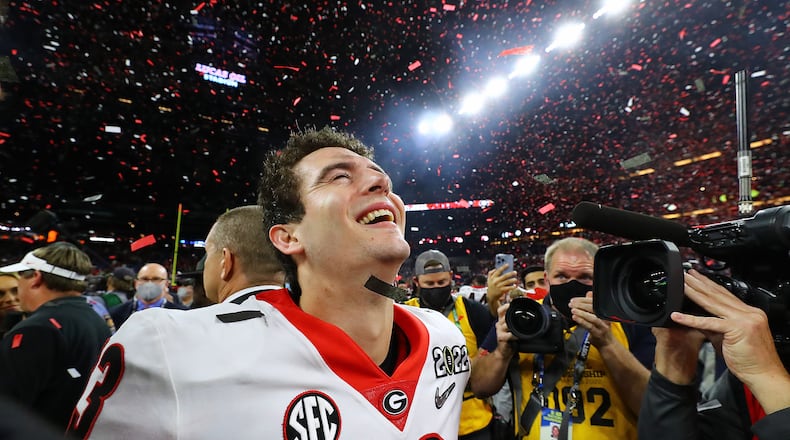College football’s focus now is back on the field, at least temporarily, after a chaotic offseason dominated by such issues as player pay, transfers, conference realignment, coaches’ salaries and the like.
As significant as those topics are, the season will be, for many, a welcome respite from the off-the-field turmoil.
“College athletics is going through the biggest transition and evolution since it was created,” said Gary Stokan, president and CEO of Peach Bowl Inc. “This is truly a monumental time in college athletics.”
But, he added, “once the college football season gets here, we start to narrow in and focus on the games, and that will take precedence for everybody.”
It won’t be the same as it used to be, of course.
After decades of rigid NCAA rules that prevented college athletes from being paid for endorsements, autographs and the like, many players enter this season with significant name, image and likeness (NIL) deals, and others will be able to cash in almost immediately from big performances. Collectives, which barely existed a year ago, are in place to pool loosely defined NIL money from boosters and businesses and pass it on to athletes at most major programs. And more than 1,500 FBS players are on different teams than last year as a result of the transfer portal.
“Basically, it’s ‘NFL Lite’ now,” said Vince Thompson, founder and CEO of Atlanta-based sports marketing agency MELT, which has done much work in the college-athletics space. “We’ve basically entered the era of free agency.”
But he sees the changes as a long-overdue improvement over the former system in which college athletes would be suspended by the NCAA for pocketing relatively small amounts of money.
“If you look back to (former Georgia football star) A.J. Green getting suspended for selling his jersey (in 2010), for goodness sake, it was ridiculous,” Thompson said. “Most people are glad the kids are finally getting their due.”
He doesn’t expect the sweeping off-the-field change to detract from the games this fall – or from the emotion surrounding them.
“The funny thing is, I think it is going to drive up fan interest,” Thompson said. “I don’t think it’ll be a diminished product on the field. … Despite the chaos and turmoil, as it relates to the business of college football, it’s never been healthier, in my opinion.”
The issues that have enveloped college sports won’t go away over the next four months, but many of them will go on the back burner as games are won and lost, conference championships decided, College Football Playoff berths debated. Longer term, it remains unclear how all of this will play out.
SEC Commissioner Greg Sankey said in Atlanta at SEC Media Days in July: “It is never going to be the same (as it was), but it doesn’t have to be the way that it is.”
Just 14 months ago, new state laws took effect around the nation, enabling college athletes to make money from name/image/likeness without jeopardizing their eligibility. Those laws, combined with a U.S. Supreme Court rebuke of the NCAA’s business model, caused the NCAA to back down on NIL issues. The almost immediate emergence of collectives has blurred – or obliterated – the line between the athletes’ long-overdue NIL rights and the NCAA’s still-on-the-books bylaws against pay-for-play or recruiting inducements.
“The things that are in support of the student-athlete, I think for the most part are positives that are going on right now,” said Stokan, whose Peach Bowl organization also runs Atlanta’s season-opening Chick-fil-A Kickoff games. “I think some of the guidelines, like on NIL with different states having different laws, need to get cleaned up. And I think the transfer portal is causing some consternation.
“I don’t think the fan is looking at transfers and NIL as something that is necessarily going to hurt college football if there are guidelines. If it stays the ‘Wild, Wild West,’ like it is now, then yeah, I think over time it would hurt college football.”
But for now, he contended, “college football is the second most favored sport in this country, behind only the NFL, in fan avidity.”
Stokan, among others, believes major-college football needs to break away from the NCAA and be overseen by its own commissioner and a board of directors.
Many college coaches and administrators continue to push for federal legislation that would set consistent NIL rules from state to state. “A patchwork of state laws was the most ineffective way to approach name, image and likeness,” Sankey said last month. But there has been little movement in Congress toward such an intervention and no consensus about what federal legislation should entail.
Many other issues continue to swirl: expansion of the College Football Playoff from four teams to an undetermined number when the current deals expire following the 2025 season; the coming moves of USC and UCLA from the Pac-12 to the distant Big Ten, of Texas and Oklahoma from the Big 12 to the SEC and undoubtedly of other teams from one league to another; the search for a new NCAA president to succeed Mark Emmert; ongoing legal challenges to various aspects of college athletics’ business model; the implementation of a drastic restructuring of the NCAA.
“I just think it’s a perfect storm,” Thompson said of the multiple issues. “You had the leadership with its head in the sand. You had massive amounts of money. You had all these tools and technology. And then you have these kids who are digital natives and have a different world view. I think it just all sort of crescendoed at the same time.
“Here’s the fascinating thing: Nothing is off the table any more.”
But when Georgia meets Oregon in Mercedes-Benz Stadium on Saturday, followed two days later by Georgia Tech versus Clemson in the same building, such issues won’t be foremost on the minds of the fans in the stands.
About the Author
Keep Reading
The Latest
Featured


